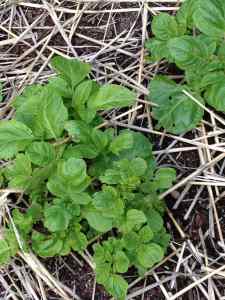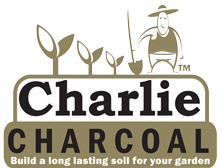| item(s), Total: $0.00 View Cart |
| Shopping cart is empty. |
Potatoes - Determinate or Indeterminate?

Potatoes - Determinate or Indeterminate? That is the question...
Potatoes are in the Solanum family - which means they're related to Tomatoes and Chillies. Tomato growers are usually familiar with the terms 'determinate' and 'indeterminate' (Determinate tomatoes stop growing after a certain point and fruit tends to form around the same time, while indeterminate ones keep growing and producing fruit over a longer period.) So - because potatoes and tomatoes are distant cousins - people often talk about whether potatoes are determinate or indeterminate. However, there's very little information available about which varieties are which, and even commercial growers don't know - and really don't care. So why not? Well, it seems these terms aren't very helpful when it comes to potatoes.
When people talk about determinate and indeterminate potatoes, they're usually talking about the structure of the plant above ground. A determinate potato plant will stop growing after reaching a certain height, while an indeterminate one will keep growing and producing foliage. However, this doesn't necessarily translate to the growth of the tubers, which is what most people are interested in when it comes to potatoes. We've always thought that hilling up potatoes will lead to more tubers being formed - which is the concept of planting in potato towers. But commercial growers certainly don't go to this trouble. Is it worth it? It seems hilling does work - but only to a point; and whether the variety makes much difference? The jury is undecided. (Note: hilling is definitely beneficial to ensure good drainage (potatoes will rot if too wet), and also to keep tubers that form away from the light - you don't want them going green.)
Generally the difference between potatoes is the above ground growth, and its flowering habit (yes, potatoes often flower). Determinate potatoes normally grow to about 50 - 70cms tall. Indeterminate varieties can grow stems as metres long, (hence the name 'potato vine'). While a determinate variety will produce a single crop of flowers & berries, ripening at roughly the same time, an indeterminate plant can flower and form new berries along the length of its above ground stems, as it continues to grow.
So basically - determinacy & indeterminacy works the same way in tomatoes and potatoes. But here's the catch. Many people conclude that the underground structure does the same thing, and that the plant will continue to produce more lateral stolons with more potatoes. Unfortunately, that isn’t the case.
Potato tubers are not fruits; they are modified stem material and remain connected and actively growing until the season ends for the plant. (In an indeterminate tomato crop - ripe fruit is picked or would simply fall off when ripe. New flowers & fruit form and receive energy from the plant. This succession does not occur in potatoes.) So if indeterminate potatoes did produce additional levels of tubers, tuber size and yield would be smaller, which is not something that most people would want.
So determinacy is not really a useful concept with potatoes, (unless you are interested in the flowering or the structure of the foliage). When it comes to tubers, it makes little difference. Potatoes all form tubers in the same way, determinate or indeterminate, whether you grow them straight in the ground or in a tower.
 It seems that the most important thing is to make sure you have healthy and vigorous plants - whether they're determinate or indeterminate or in between; if the plant can reach maturity faster, with healthy foliage, the plant will be able to produce enough energy to form good tubers. The longer the plant can actively grow, the more (and larger) potatoes you're likely to achieve. Yield seems more to do with healthy soil and early planting. If you have earlier maturing varieties you get to harvest earlier and can then plant other vegies (or successive potato crops - so you'll end up with more potato crops in less space). If you have later season varieties you'll have them in the ground longer (taking up space but you may end up with larger and/or more spuds to harvest). So it's swings and roundabouts from what I can research.
It seems that the most important thing is to make sure you have healthy and vigorous plants - whether they're determinate or indeterminate or in between; if the plant can reach maturity faster, with healthy foliage, the plant will be able to produce enough energy to form good tubers. The longer the plant can actively grow, the more (and larger) potatoes you're likely to achieve. Yield seems more to do with healthy soil and early planting. If you have earlier maturing varieties you get to harvest earlier and can then plant other vegies (or successive potato crops - so you'll end up with more potato crops in less space). If you have later season varieties you'll have them in the ground longer (taking up space but you may end up with larger and/or more spuds to harvest). So it's swings and roundabouts from what I can research.
Our potato producers in Australia seem to think that the popular varieties here are 'in between determinate and indeterminate' - which isn't very helpful; but - at the end of the day - also isn't very important; so it seems. What really matters to commercial growers is their yield. And this seems to improve with later maturing potatoes - which keep growing until they die back at the end of their season. But how do you judge early or late maturity? It can vary so much with the season, the microclimate in your own garden (sun/shade/watering) etc. Sigh. (Potatoes begin to form 6-8 weeks after planting, and you harvest them once tops die back; usually late spring - but we're usually talking 3-5 months after planting until maturity. You can always carefully dig around to find potatoes to harvest and to check their development. If frost kills off your potatoes early - leave them in the ground and hopefully they'll re-sprout.)
So don't be disheartened. It seems there's no need to really know or care whether your spuds are one or the other. Yay! More brain space for something else...
What IS important (at least to me!) is the taste of organically home grown spuds; which no matter if you like 'em boiled, mashed, roasted, chipped or in soups and stews - is something that can't be disputed!
Get Growing Today!
Come on in!
Pick up bags or bulk product
bring your trailer (or use one of ours)
Opening hours:
8.30 - 4.00 Monday - Friday
8.30 - 2.00 Saturday
(closed Sunday)
Shop Online - We Deliver
24/7 convenient & secure online shopping or support your local independent retail outlet. Join our Newsletter for Perth gardening advice and exclusive offers.
Get Growing
We guarantee our products. Ask our friendly staff for help & advice ~ we're here to help you achieve the garden of your dreams.
























